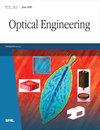基于尺度不变特征变换特征的图像捕捉和拼接系统,适用于无纹理和光滑物体
IF 1.2
4区 工程技术
Q4 OPTICS
引用次数: 0
摘要
摘要许多拼接研究都采用了改进的尺度不变特征变换(SIFT)或加速鲁棒特征(SURFs)拼接算法,因为它们对输入图像的尺度和旋转变化具有出色的鲁棒性。传统的基于 SIFT 的拼接算法存在从无纹理和光滑物体中提取和匹配的特征点不足的局限性,从而导致拼接失败。为了克服这一问题,我们提出了一种在提取和描述特征点之前使用激光图案投影(LASPP)贴图技术的系统。建议的系统可以基于 SIFT 特征提取技术提取和描述特征点。采用渐进式样本一致性(PROSAC)算法去除错误匹配点,提高特征点匹配的准确性。实验结果清楚地显示了使用 LASPP 投影的模式对拼接结果的影响。此外,还比较了采用 PROSAC 算法的拟议系统与采用随机样本共识算法的传统系统在匹配特征点方面的效率。此外,还将拟议系统的拼接质量与其他基于 SIFT 和 SURF 的拼接系统进行了比较。本文章由计算机程序翻译,如有差异,请以英文原文为准。
Image capturing and stitching system based on scale-invariant feature transform features for untextured and smooth objects
Abstract. Many stitching studies employ improved scale-invariant feature transform (SIFT) or speeded up robust features (SURFs) stitching algorithms, owing to their excellent robustness against variations in scale and rotations of input images. Traditional SIFT-based stitching algorithms suffer from the limitation of having insufficient feature points that can be extracted and matched from untextured and smooth objects, resulting in stitching failure. To overcome this issue, we propose a system that uses a proposed laser pattern projection (LASPP)-pasted texture technique before feature point extraction and description. The proposed system can extract and describe feature points based on SIFT feature extraction techniques. The progressive sample consistency (PROSAC) algorithm was used to remove false matching points and enhance the accuracy in matching feature points. The experimental results clearly revealed the effect of the pattern projected using LASPP on the stitching results. Furthermore, the efficiency of the proposed system, which employed the PROSAC algorithm, in matching feature points, was compared with that of the traditional system, which used the random sample consensus algorithm. Additionally, the stitching quality of the proposed system was compared with that of other SIFT- and SURF-based stitching systems.
求助全文
通过发布文献求助,成功后即可免费获取论文全文。
去求助
来源期刊

Optical Engineering
工程技术-光学
CiteScore
2.70
自引率
7.70%
发文量
393
审稿时长
2.6 months
期刊介绍:
Optical Engineering publishes peer-reviewed papers reporting on research and development in optical science and engineering and the practical applications of known optical science, engineering, and technology.
 求助内容:
求助内容: 应助结果提醒方式:
应助结果提醒方式:


